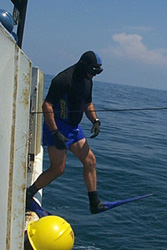|
 |
|
Daily
At-Sea Logs |
Tuesday, May 18, 2004 Greetings from Gray’s Reef! The day’s operations have been similar to the others, more fish traps, dives, and video loggers were deployed. This morning, around 0730 hours, George’s crew was back at it again; deploying and retrieving fish traps. However, this morning was a bit different from the others. George had requested that we drop one trap directly in an area of high relief, with the most reef structure; another trap 200 meters from the first; and then another 400 m from the first that was even farther from the reef. Once the traps were recovered, we found that the first trap caught the black sea bass, which is no surprise because it is a reef fish. The second trap collected fish species that forage in the sand, like scup. And finally, the third trap, which was positioned far from the reef, did not catch any fish. From these three traps, we can infer that the species vary with distance from the reef.
It seems that we have run upon one more problem this evening; Daniela and Kate decided to finally calibrate the transducer. Unfortunately, it appears that something has gone wrong in the process, and the unit is not responding. Dr. Di Iorio believes that the unit was removed from the water before it was shut down. She will have to conduct some additional tests and read more about the instrument in order to assess the damage. Until then, we have our fingers crossed that the instrument is not broken beyond repair. It is hard to believe that our trip is coming to a close. Seems like it has been just a couple of days since we were just boarding the Nancy Foster. While I miss my family and friends, as well as my life back in Charleston, it is easy to see how people get adjusted to life at sea and make a ship like this one, home. The inhabitants on this boat eventually get used to one another, and the next thing you know, we are one big family. That’s the great thing about going on trips like this one; you get the opportunity to meet like-minded people that you can build relationships with. The bonds created and the experiences shared here in Gray’s Reef are ones that I will likely not forget. Most everyone here, whether they are a seasoned scientist, technician, or student, learns something new and their perspective broadens, as a result. This is especially true for me, a future middle school science teacher. I will have many more stories to add to my repertoire that will hopefully hook students in science. And most importantly, I have additional real hands-on experience that will provide a context for my teaching. I’m feeling pretty exhausted this evening and I hope to catch the sunset before watching a movie in the TV room. Feels like a good night for Finding Nemo. Until then, Elizabeth
|
|||||||||


 During
the course of the day, we had a small problem while retrieving one
fish trap. The line was snagged in one of the propellers that guide
the ship’s direction, called the Z drive. Our fearless leader,
Greg, quickly jumped in the water with his snorkel gear
(picture on right) after the propellers were switched off,
of course, removed the line, which allowed the fish trap to be pulled
on board.
During
the course of the day, we had a small problem while retrieving one
fish trap. The line was snagged in one of the propellers that guide
the ship’s direction, called the Z drive. Our fearless leader,
Greg, quickly jumped in the water with his snorkel gear
(picture on right) after the propellers were switched off,
of course, removed the line, which allowed the fish trap to be pulled
on board.